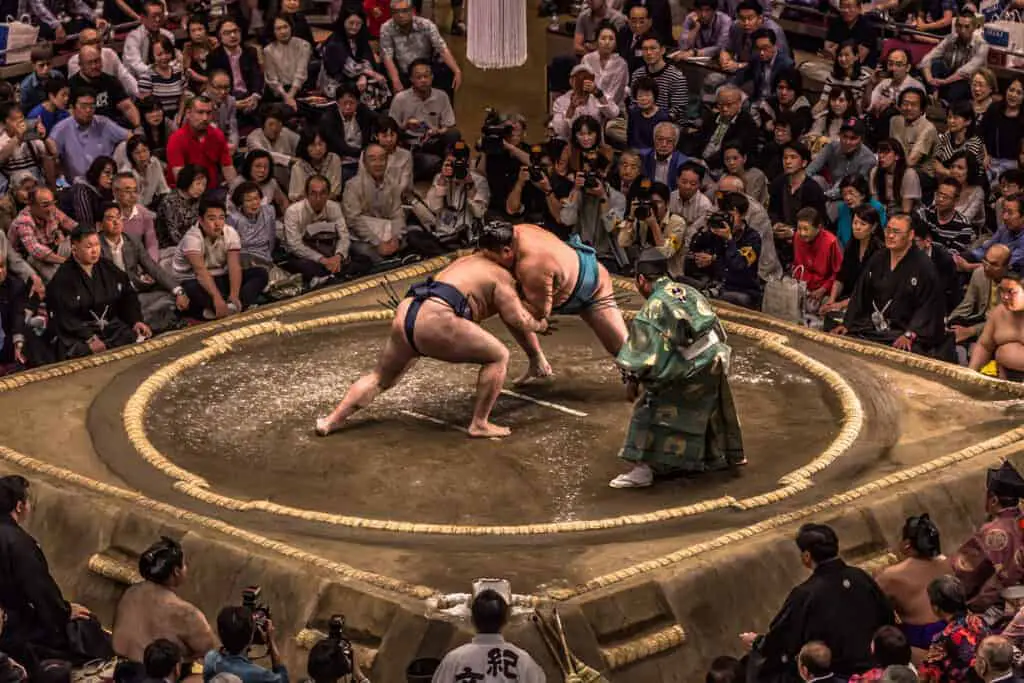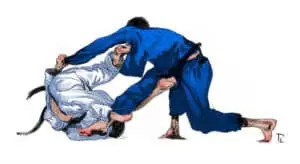Everyone knows how enormous Sumo wrestlers are. The average weight of a top professional Sumo wrestler is 330 pounds (150kg). To achieve this impressive size do they lift weights or is it just from eating and wrestling? Lets find out!

Do Sumo wrestlers lift weights? Traditionally Sumo wrestlers did not lift weights as it was thought to have a negative effect on performance. However, currently many Sumo wrestlers have incorporated weight training into their routines. Chiyonofuji and Akebono were some of the first Sumo wrestlers to lift weights.
What Type Of Weight Training Do Sumo Wrestlers Do?
Sumo wrestlers typically focus on high reps with low to moderate weight as they do not want to risk injury. They focus on weight training exercises which mimic Sumo movements. A common exercise is holding a weighted Bulgarian bag and moving forward and backwards in the Sumo squat stance. Other common exercises include weighted sled and tire pushes.
Here Is Kotoshogiku Pushing A Tire
Sumo wrestlers are fond of dumbbells. They will often use dumbbells to strengthen their arms and shoulders. Lateral and frontal raises are popular exercises as well as curls and shoulder press.
Here Is Kotoshogiku Performing 100 Reps Of Dumbbell Swings
Classic strength training exercises such as squat, deadlift and bench press are uncommon in Sumo. These are viewed as dangerous and not having a positive effect on wrestling performance due to making the athlete slow and stiff. As the younger Sumo are not allowed to leave their training stables and most stables do not have weightlifting equipment even if the Sumo wrestlers wanted to perform these exercises they wouldn’t be able to.
Without training powerlifting movements I’m sure Sumo wrestlers would still be able to lift incredible amounts of weight. Particularly, in the squat as they spend hours every day moving and fighting in a squat stance.
Is Weightlifting A Major Part Of Sumo Wrestling?

No, weightlifting is not a major part of Sumo wrestling. In fact, for most of Sumo’s existence it has played no role in the sport. To this day weightlifting is a minor part of Sumo and many wrestlers do not train in weightlifting and instead focus on the traditional exercises.
Weightlifting is still controversial in Sumo. Many stable masters will not allow their wrestlers to lift weights. Very few stables have any weightlifting equipment and if they do it will only be a few dumbbells, kettlebells and some weighted bags. Do not expect to see squat racks, benches and a bunch of weightlifting machines if you ever visit a Sumo stable.
If Sumo wrestlers are allowed to weight lift it usually happens in their personal time after they have completed their mandatory training. Sumo trainers do not view weight lifting as a major importance and they do not want it to impact on their wrestlers’ main training routines.
Do All Sumo Wrestlers Lift Weights?

No, many Sumo wrestlers do not lift weights. I would estimate only 20% of wrestlers actually do any weightlifting and less than 5% actually perform heavy weightlifting exercises such as squats and bench press. Most Sumo wrestlers prefer to spend their training time practicing the sport of Sumo.
As Sumo wrestlers are so large they have to be careful not to over train as injuries can be common. Instead of using up their energy lifting weights they instead choose to spend their training pushing and throwing their training opponents around and out of the ring.
Some Sumo wrestlers who have wanted to lift weights have faced criticism. Asashōryū a Mongolian Sumo wrestler who never cared too much for the Japanese traditions was often reprimanded for his weight training. Sumo is a very traditional sport and coaches exhibit lots of control over their wrestlers. Many coaches do not like weightlifting and won’t let their wrestlers lift weights at all.
What Exercises Do Sumo Wrestlers Do Instead Of Weightlifting?
Sumo wrestlers follow a strict training routine and perform a variety of traditional exercises based on the specific movements that can be found in Sumo. Sumo wrestler’s typically start their training early in the morning sometimes as early as 6am. Training can often last for 3 hours as wrestlers perform hundreds of reps and do round after round of live wrestling.
Here Is An Example Of A Sumo Training Session:
Shiko – ritual stomping, stand in squat position, hands on knees, raise one leg as high as possible and slowly lower it, Shiko helps a Sumo wrestlers improve their stance while developing their leg and hip strength, repeat movement 100-300 times – 30mins
How To Perform Shiko
Teppo – push against wooden pole, perform a push up while at the same time swing their leg forward, first make contact with one arm and then swing the opposite leg as you make contact with second arm before pushing yourself away from the pole, Teppo helps Sumo wrestlers learn how to effectively push their opponents, repeat movement 300 times – 30 mins
How To Perform Teppo
Matawari – forward leg split with stomach touching ground, hold for as long as possible, get partner to push your back, Sumo wrestlers need to be flexible to maintain their balance and avoid their opponent’s attacks, performing regular Matawari will give you gymnastesque flexibility in no time, repeat movement for 15-30mins
How To Perform Matawari
Moshiai – sparring, mock matches where Sumo wrestlers will compete against each other, the most difficult part of training – 60-90mins
How To Perform Moshiai – Watch Champions Asahoryu and Harumafuji Go At It
Butsukari Geiko – this is where wrestlers practice launching themselves into their opponent and pushing them across the ring, their training partner’s will offer varying levels of resistance, this exercise helps Sumo wrestlers improve their starting position and their leg driving power which is vital to win matches
Here Is Sumo Wrestlers Performing Butsukari Geiko Back In 1978
How Strong Are Sumo Wrestlers?

There haven’t been many studies done testing the strength of Sumo wrestlers. Ogawa et al. (1973) tested the grip strength of Sumo wrestlers and found they averaged 47.9kg which was less than Olympic weightlifting and throwing athletes but still much higher than untrained men.
Sumo wrestlers are incredibly strong. You will often see Sumo wrestlers picking each other up and walking and throwing their opponents out of the ring. Seeing as the average Sumo wrestler weighs 330 pounds (150kg) this is an amazing feat of strength.
Sumo wrestlers do not perform classic tests of strength such as bench press, squat and deadlift. So it is difficult to know how strong they would be in these lifts. Based on the stress Sumo wrestling places on the and legs and the rigorous training Sumo wrestlers engage in it is likely they would be able to deadlift and squat very large weights.
Conclusion
Traditionally Sumo wrestlers did not lift weights. Instead they focused on performing bodyweight exercises and practicing wrestling techniques. However, in recent years modern training techniques have entered Sumo as athletes and coaches are looking for new ways to gain an advantage over their competition. Currently, weightlifting is still fairly uncommon in Sumo and if athletes do lift weights they will typically do high reps and low weight, using dumbbells, weighted bags, sleds and kettlebells. There is still a lot of push back against weightlifting in Sumo which is why many wrestlers continue not to engage in any form of weightlifting training.
